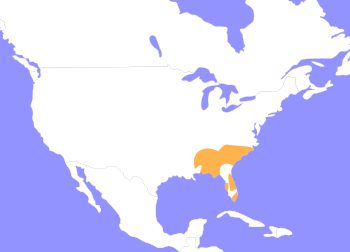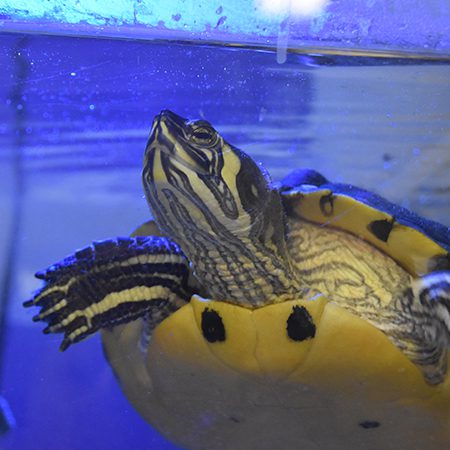Yellow Bellied Slider
Trachemys scripta scripta
Yellow-bellied sliders are very common turtles across central and eastern United States. Sliders in general can be found just about anywhere in the world, though they may not be native. They are semi-aquatic, meaning they do not spend all of their time in the water, but it is a majority of their life. They need diverse vegetation and places to bask. Sliders can be seen basking in large numbers together at a water source. The water needs to be somewhat, if not completely, freshwater. They have been found in brackish water, which is an area where fresh and saltwater meet and mix together; usually where rivers flow into the ocean.
Females tend to be larger than males and aren’t considered adults until they are 5-8 years old. Males, on average, are several inches smaller and are mature by 2-5 years old. Their upper shell (the carapace), tends to be a dark green to black and sharp on the edges. The plastron (the lower shell) is a bright yellow, which is what they get their name from. Occasionally, there are black spots or streaks. The skin of the turtle tends to be the color of the carapace with yellow streaking from the face to the chest. They have webbed feet with claws at the end of each finger, as opposed to sea turtles that just have flippers. They are able to walk and run on land as well as being avid swimmers.

Yellow Bellied Sliders are native to southeastern United States, specifically from Florida and parts of Virginia.
HABITAT -They live in freshwater or brackish (a mix of fresh and salt water) water.
DIET -As adults, they are omnivorous, and eat more plants. Juveniles will eat invertebrates.
FUN FACT -This turtle gets the name "slider" from its tendancy to quickly slide off of rocks or shore lines into the water at the first sign of danger.
SOCIAL BEHAVIOR -They are gregarious animals, living in large numbers, and are friendly with humans.
ACTIVITY -They are diurnal, being active when it is warm out.
PREDATORS -They are eaten by large reptiles, birds, mammals, and humans.
SIZE -They grow around 8-11 inches long and weigh about 2-3 pounds on average.
RELATIVES -They are related to other sliders, like the red-eared or Cumberland sliders.
CONSERVATION -Yellow-bellied sliders are listed as LC (Least Concern) according to the IUCN.
Cub Creek Animal Care Information
Housing - Our four sliders live in three different aquariums throughout the animal area. Our largest and oldest lives in his own 80-gallon tank in the Small Animal Room. He has plenty of space to swim around as well as a basking spot. Our smaller sibling turtles live together in another 80-gallon. Our newest and most shy turtle is in his own 50-gallon tank. Both of those tanks are filled with different size rocks and driftwood to create places to explore and bask. We give them all a UV and a heat lamp to ensure they are warm and healthy.
Diet - All our sliders are fed ReptoMin turtle pellets that are specially formulated to ensure the turtles get all the necessary nutrients. These pellets include fish meal, shrimp meal, and a variety of vitamins and minerals to provide them all the nutrition they need. On Tuesdays, Slip gets a pinky mouse as a treat, and they are all fed greens on occasion.
Enrichment - Their aquariums are set up to provide plenty of enrichment every day. In the summer, they are also taken out and handled by the campers which gives them lots of stimulation.

